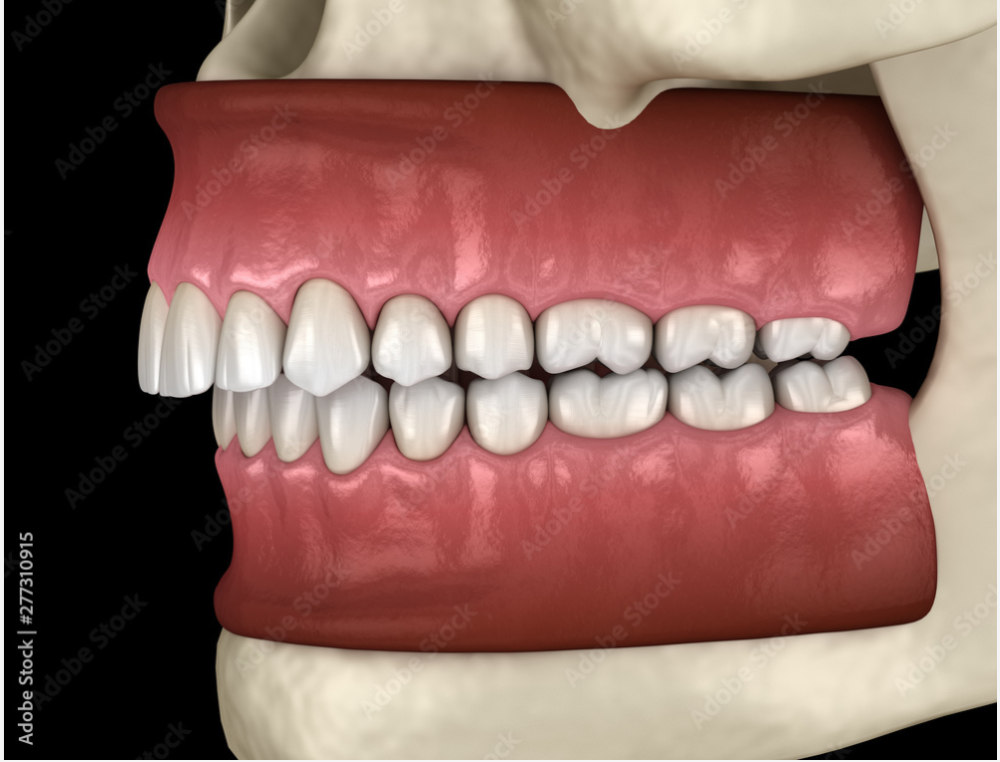class ii malocclusion definition
Definition of a class 3 malocclusion. There are two subtypes of Class II malocclusion.
A Class 2 molar relationship is described as.

. The largest category was mandibular asymmetry. In this type of malocclusion your upper teeth and jaw. Class II malocclusion.
The maxillary first molar is inline with or anteriorly positioned relative to the mandibular first molar. CLASS II MALOCLUSION THE MESIOBUCCAL CUSP OF THE LOWER FIRST PERMANENT MOLAR OCCLUDES DISTAL TO THE CLASS I POSITION. Almost always it is the retrusive lower jaw that is causing this type of malocclusion.
Class II division II if the incisors are retroclined. The cusp of the upper first molar rests in the groove of the lower first molar. Class II malocclusion is considered the most frequent problem presenting in the orthodontic practice affecting 37 of school children in Europe and occurring in 33 of all orthodontic patients in the USA.
Class 3 malocclusion called prognathism or underbite occurs when the lower jaw protrudes or juts forward causing the lower jaw and teeth to overlap the upper jaw and teeth. Class II Division 2 is where the maxillary anterior teeth are retroclined and a deep overbite exists. CLASS II DIVISION 1 Condition when class II molar relationship is present with proclined upper central incisors.
Class II division I if the incisors are proclined. The class II malocclusion. Class 2 malocclusion called retrognathism or overbite occurs when the upper jaw and teeth severely overlap the bottom jaw and teeth.
Contrary to class 2 class 3 malocclusions are characterized by lower molars that are too far forward compared to the upper molars. People with this underbite often have a. Interesting trends were noted with regard to treatment strategies midline and molar corrections and mandibular incisor proclination.
This often results in mandibular canine teeth traumatizing the palate. Upper incisors are tilted outwards creating significant overjet. The mesiobuccal cusp of the maxillary first molar occluding anterior to the buccal groove of the mandibular first molar ie.
It must been understood that Class II malocclusion occlusal severity specification is correlated to treatment plan and time and to the mechanical difficulty in handling the malocclusion and therefore it has to be precisely described 21014212241. Class II Malocclusion Class II Malocclusion Class II Malocclusion has two divisions to describe the position of the anterior teeth. Class II subdivision malocclusions were grouped into 3 main categories.
The mandible resides distal caudal to its normal location in relation to the maxilla Photo 5. Class II malocclusion is divided into. The bite however is normal.
Class II malocclusion includes those anomalies with the mesiobuccal cusp of maxillary first permanent molar occludes mesial to the mesiobuccal grove of the mandibular first permanent molar. Class 2 malocclusion is diagnosed when you have a severe overbite. Class II Division 1 is when the maxillary anterior teeth are proclined and a large overjet is present.
Mandibular distoclusion Class 2 malocclusion. However there might be spacing overcrowding under eruption or over eruption with respect to the. The usual treatment options in growing patients.
Depending on whether there is a vertical or horizontal protrusion this form of malocclusion is commonly referred to as either an overbite or overjet. The American Veterinary Dental College defines Class II malocclusion as mandibular distocclusion when there is an abnormal rostro-caudal relationship between the dental arches in which the mandibular arch occludes caudal to its normal position relative to the maxillary arch Figure 3. Class II division 2.
Differential diagnosis and clinical application of activators extraoral traction and fixed appliances. Class II malocclusion. Class 3 is the rarest type of malocclusion.
Upper incisors are labially inclined. Vertical dimension in class II division 2 malocclusion is typically reduced results in absence of occlusal stop to lower incisors leading to increased overbite. Class II malocclusion occlusal severity features should be more thoroughly described in scientific papers to provide a better.
Class II malocclusions with asymmetry or severe mandibular deficiency. The mesiobuccal cusp of the upper first molar occludes anterior to the buccal groove of the lower first molar. Terms that have commonly been associated with class II.
1 Class II malocclusion may also involve craniofacial discrepancies which can be adjusted when patients are adolescent. Class II malocclusions occur when the upper teeth are positioned too far ahead of the lower teeth. Dental malocclusions are classified based on the positioning of the upper and lower molars.
DENTAL FACTORS Pre-existing crowding is exacerbated because retroclination of upper central incisors. Class II division 1. Class 1 Malocclusion Neutrocclusion This is the most common type of malocclusion in which the upper teeth overlap the lower teeth.
Progressive deformity is associ-ated with mechanical limitations on growth and the resulting condition is referred to as functional 336 SPECIAL REPORT -- ETIOLOGY OF CLASS II. There is an increase in overjet.
Treatment Of Class Ii Malocclusions
Definition Etiology And Treatment Of Class Ii Malocclusion
Treatment Of Class Ii Malocclusions
Introduction To Oral Dental Anatomy And Morphology Ppt Download
Treatment Of Class Ii Malocclusions
4 Class Ii Division 1 Malocclusion Pocket Dentistry
What Is A Class 2 Malocclusion Dental Information
Angle S Classification For Malocclusions Dentalnotebook
Angle S Classification For Malocclusions Dentalnotebook
The Aetiology Of Class Ii Malocclusion Ppt Video Online Download
Types Of Malocclusion And Correction Winchester Dental
Definition Etiology And Treatment Of Class Ii Malocclusion
Class Ii Division 1 Malocclusion
5 Class Ii Division 2 Malocclusion Pocket Dentistry
Common Malocclusions Dr Jean Cassar Orthodontist
